Financial Accounting Principles: Homework Assignment Solution
VerifiedAdded on 2020/07/22
|28
|2413
|53
Homework Assignment
AI Summary
This document presents a comprehensive solution to a financial accounting assignment. It begins with an introduction to financial accounting, its role in determining a business's financial performance, and the importance of financial statements. The solution then delves into relevant acts, accounting rules, principles, conventions, and concepts like consistency and material disclosure. It includes examples and explanations of journal entries, the double-entry system, ledgers, trial balances, and the preparation of financial statements (profit and loss, financial position). The assignment also addresses bank reconciliation statements, control accounts (sales and purchase ledger), and suspense accounts. The solution covers key accounting concepts, provides practical examples, and offers a detailed analysis of various financial accounting aspects.
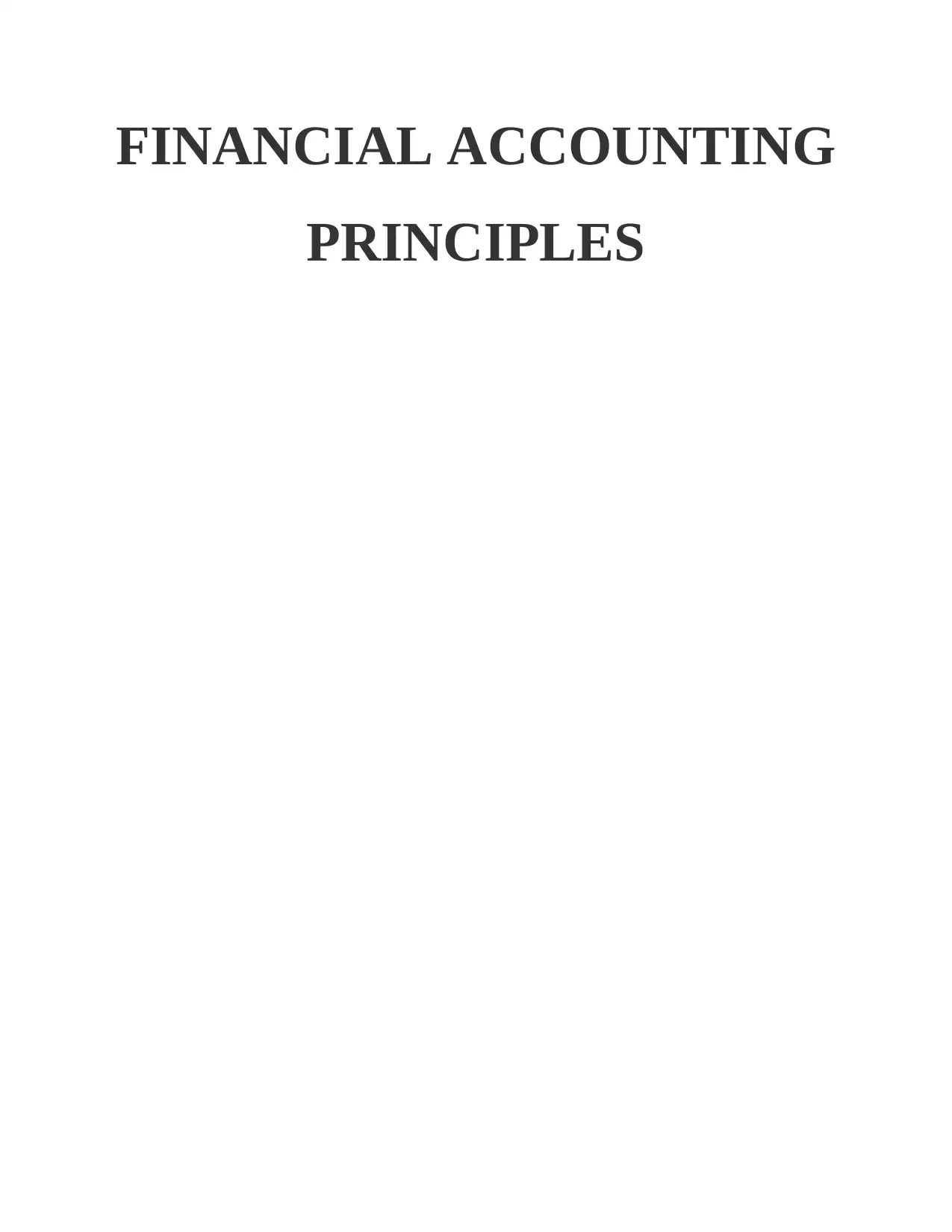
FINANCIAL ACCOUNTING
PRINCIPLES
PRINCIPLES
Paraphrase This Document
Need a fresh take? Get an instant paraphrase of this document with our AI Paraphraser
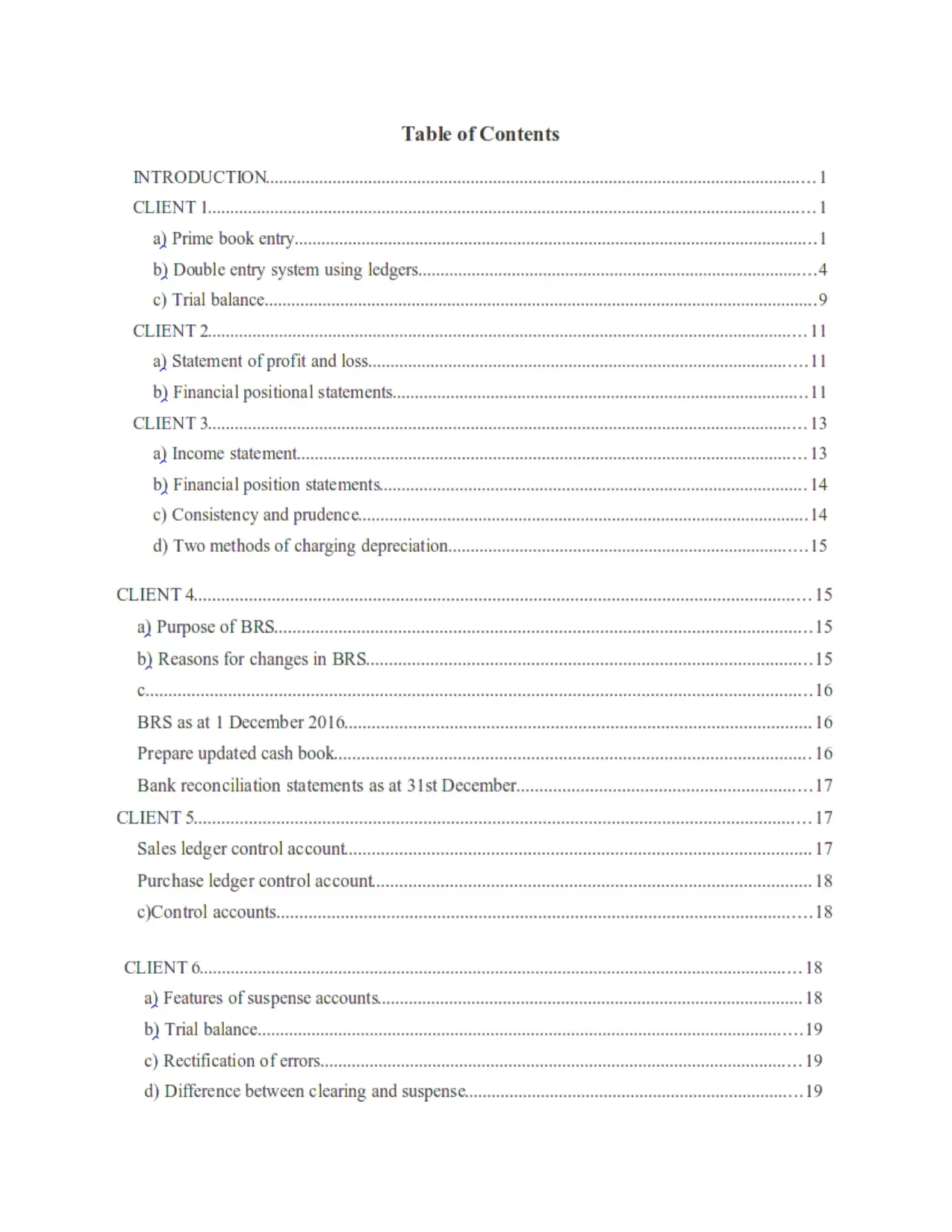

⊘ This is a preview!⊘
Do you want full access?
Subscribe today to unlock all pages.

Trusted by 1+ million students worldwide
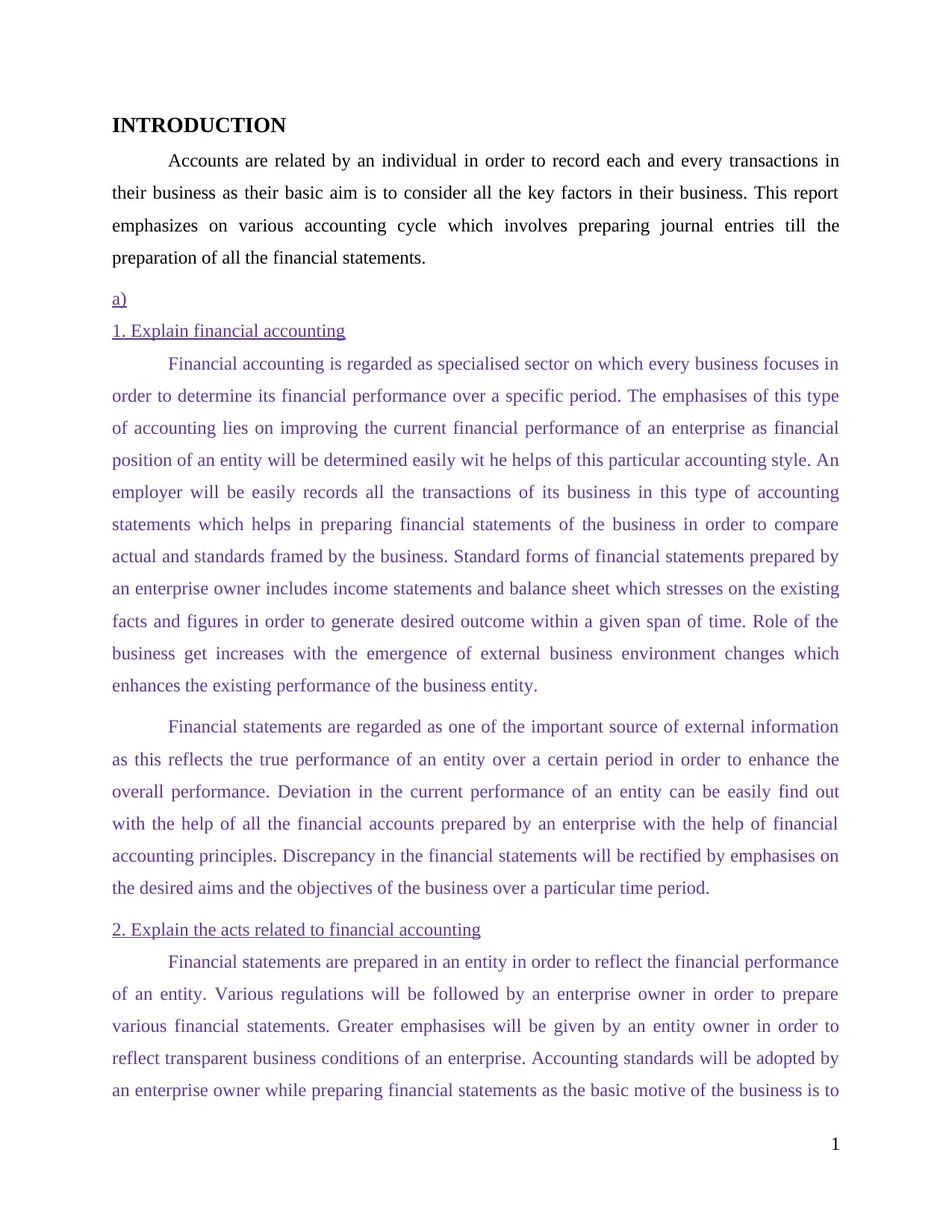
INTRODUCTION
Accounts are related by an individual in order to record each and every transactions in
their business as their basic aim is to consider all the key factors in their business. This report
emphasizes on various accounting cycle which involves preparing journal entries till the
preparation of all the financial statements.
a)
1. Explain financial accounting
Financial accounting is regarded as specialised sector on which every business focuses in
order to determine its financial performance over a specific period. The emphasises of this type
of accounting lies on improving the current financial performance of an enterprise as financial
position of an entity will be determined easily wit he helps of this particular accounting style. An
employer will be easily records all the transactions of its business in this type of accounting
statements which helps in preparing financial statements of the business in order to compare
actual and standards framed by the business. Standard forms of financial statements prepared by
an enterprise owner includes income statements and balance sheet which stresses on the existing
facts and figures in order to generate desired outcome within a given span of time. Role of the
business get increases with the emergence of external business environment changes which
enhances the existing performance of the business entity.
Financial statements are regarded as one of the important source of external information
as this reflects the true performance of an entity over a certain period in order to enhance the
overall performance. Deviation in the current performance of an entity can be easily find out
with the help of all the financial accounts prepared by an enterprise with the help of financial
accounting principles. Discrepancy in the financial statements will be rectified by emphasises on
the desired aims and the objectives of the business over a particular time period.
2. Explain the acts related to financial accounting
Financial statements are prepared in an entity in order to reflect the financial performance
of an entity. Various regulations will be followed by an enterprise owner in order to prepare
various financial statements. Greater emphasises will be given by an entity owner in order to
reflect transparent business conditions of an enterprise. Accounting standards will be adopted by
an enterprise owner while preparing financial statements as the basic motive of the business is to
1
Accounts are related by an individual in order to record each and every transactions in
their business as their basic aim is to consider all the key factors in their business. This report
emphasizes on various accounting cycle which involves preparing journal entries till the
preparation of all the financial statements.
a)
1. Explain financial accounting
Financial accounting is regarded as specialised sector on which every business focuses in
order to determine its financial performance over a specific period. The emphasises of this type
of accounting lies on improving the current financial performance of an enterprise as financial
position of an entity will be determined easily wit he helps of this particular accounting style. An
employer will be easily records all the transactions of its business in this type of accounting
statements which helps in preparing financial statements of the business in order to compare
actual and standards framed by the business. Standard forms of financial statements prepared by
an enterprise owner includes income statements and balance sheet which stresses on the existing
facts and figures in order to generate desired outcome within a given span of time. Role of the
business get increases with the emergence of external business environment changes which
enhances the existing performance of the business entity.
Financial statements are regarded as one of the important source of external information
as this reflects the true performance of an entity over a certain period in order to enhance the
overall performance. Deviation in the current performance of an entity can be easily find out
with the help of all the financial accounts prepared by an enterprise with the help of financial
accounting principles. Discrepancy in the financial statements will be rectified by emphasises on
the desired aims and the objectives of the business over a particular time period.
2. Explain the acts related to financial accounting
Financial statements are prepared in an entity in order to reflect the financial performance
of an entity. Various regulations will be followed by an enterprise owner in order to prepare
various financial statements. Greater emphasises will be given by an entity owner in order to
reflect transparent business conditions of an enterprise. Accounting standards will be adopted by
an enterprise owner while preparing financial statements as the basic motive of the business is to
1
Paraphrase This Document
Need a fresh take? Get an instant paraphrase of this document with our AI Paraphraser
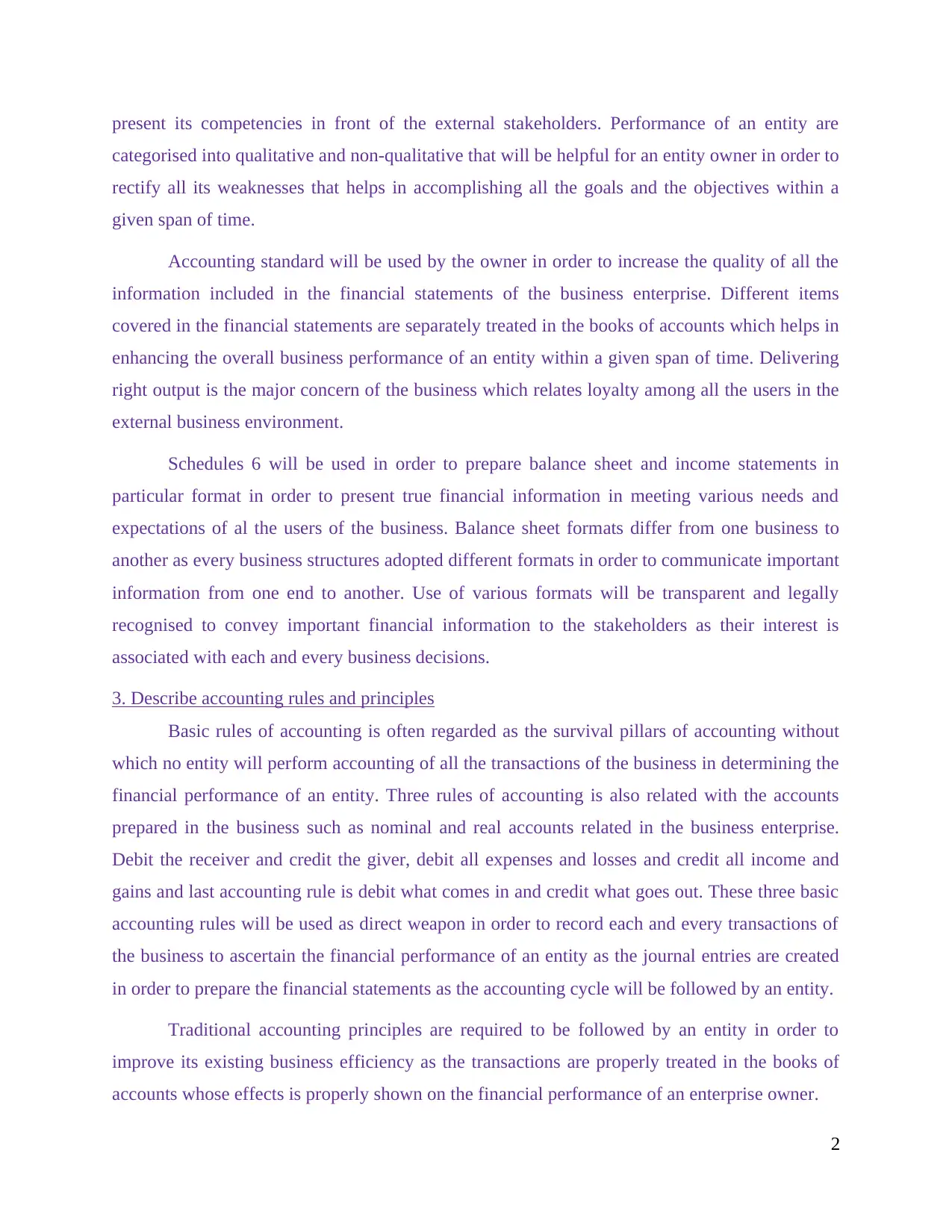
present its competencies in front of the external stakeholders. Performance of an entity are
categorised into qualitative and non-qualitative that will be helpful for an entity owner in order to
rectify all its weaknesses that helps in accomplishing all the goals and the objectives within a
given span of time.
Accounting standard will be used by the owner in order to increase the quality of all the
information included in the financial statements of the business enterprise. Different items
covered in the financial statements are separately treated in the books of accounts which helps in
enhancing the overall business performance of an entity within a given span of time. Delivering
right output is the major concern of the business which relates loyalty among all the users in the
external business environment.
Schedules 6 will be used in order to prepare balance sheet and income statements in
particular format in order to present true financial information in meeting various needs and
expectations of al the users of the business. Balance sheet formats differ from one business to
another as every business structures adopted different formats in order to communicate important
information from one end to another. Use of various formats will be transparent and legally
recognised to convey important financial information to the stakeholders as their interest is
associated with each and every business decisions.
3. Describe accounting rules and principles
Basic rules of accounting is often regarded as the survival pillars of accounting without
which no entity will perform accounting of all the transactions of the business in determining the
financial performance of an entity. Three rules of accounting is also related with the accounts
prepared in the business such as nominal and real accounts related in the business enterprise.
Debit the receiver and credit the giver, debit all expenses and losses and credit all income and
gains and last accounting rule is debit what comes in and credit what goes out. These three basic
accounting rules will be used as direct weapon in order to record each and every transactions of
the business to ascertain the financial performance of an entity as the journal entries are created
in order to prepare the financial statements as the accounting cycle will be followed by an entity.
Traditional accounting principles are required to be followed by an entity in order to
improve its existing business efficiency as the transactions are properly treated in the books of
accounts whose effects is properly shown on the financial performance of an enterprise owner.
2
categorised into qualitative and non-qualitative that will be helpful for an entity owner in order to
rectify all its weaknesses that helps in accomplishing all the goals and the objectives within a
given span of time.
Accounting standard will be used by the owner in order to increase the quality of all the
information included in the financial statements of the business enterprise. Different items
covered in the financial statements are separately treated in the books of accounts which helps in
enhancing the overall business performance of an entity within a given span of time. Delivering
right output is the major concern of the business which relates loyalty among all the users in the
external business environment.
Schedules 6 will be used in order to prepare balance sheet and income statements in
particular format in order to present true financial information in meeting various needs and
expectations of al the users of the business. Balance sheet formats differ from one business to
another as every business structures adopted different formats in order to communicate important
information from one end to another. Use of various formats will be transparent and legally
recognised to convey important financial information to the stakeholders as their interest is
associated with each and every business decisions.
3. Describe accounting rules and principles
Basic rules of accounting is often regarded as the survival pillars of accounting without
which no entity will perform accounting of all the transactions of the business in determining the
financial performance of an entity. Three rules of accounting is also related with the accounts
prepared in the business such as nominal and real accounts related in the business enterprise.
Debit the receiver and credit the giver, debit all expenses and losses and credit all income and
gains and last accounting rule is debit what comes in and credit what goes out. These three basic
accounting rules will be used as direct weapon in order to record each and every transactions of
the business to ascertain the financial performance of an entity as the journal entries are created
in order to prepare the financial statements as the accounting cycle will be followed by an entity.
Traditional accounting principles are required to be followed by an entity in order to
improve its existing business efficiency as the transactions are properly treated in the books of
accounts whose effects is properly shown on the financial performance of an enterprise owner.
2
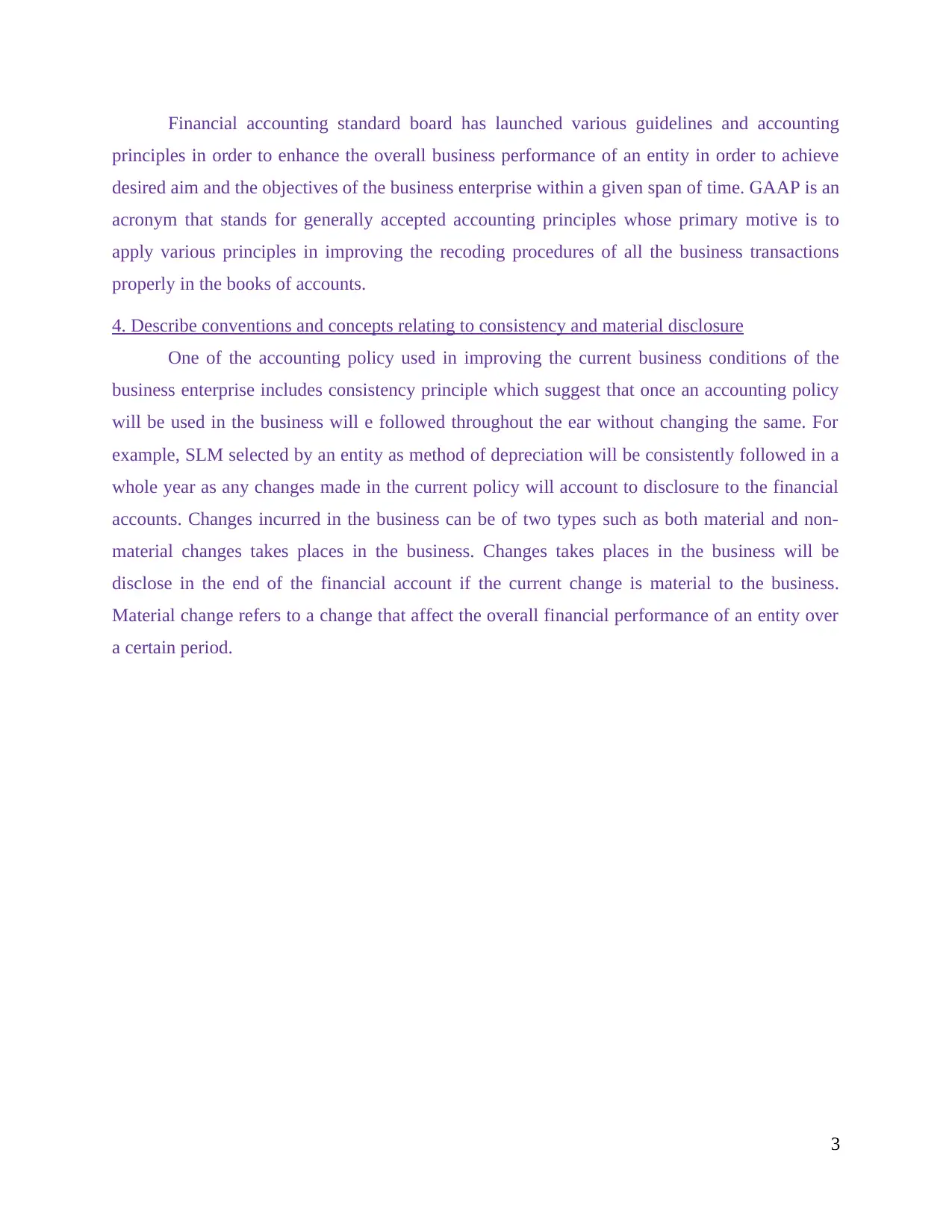
Financial accounting standard board has launched various guidelines and accounting
principles in order to enhance the overall business performance of an entity in order to achieve
desired aim and the objectives of the business enterprise within a given span of time. GAAP is an
acronym that stands for generally accepted accounting principles whose primary motive is to
apply various principles in improving the recoding procedures of all the business transactions
properly in the books of accounts.
4. Describe conventions and concepts relating to consistency and material disclosure
One of the accounting policy used in improving the current business conditions of the
business enterprise includes consistency principle which suggest that once an accounting policy
will be used in the business will e followed throughout the ear without changing the same. For
example, SLM selected by an entity as method of depreciation will be consistently followed in a
whole year as any changes made in the current policy will account to disclosure to the financial
accounts. Changes incurred in the business can be of two types such as both material and non-
material changes takes places in the business. Changes takes places in the business will be
disclose in the end of the financial account if the current change is material to the business.
Material change refers to a change that affect the overall financial performance of an entity over
a certain period.
3
principles in order to enhance the overall business performance of an entity in order to achieve
desired aim and the objectives of the business enterprise within a given span of time. GAAP is an
acronym that stands for generally accepted accounting principles whose primary motive is to
apply various principles in improving the recoding procedures of all the business transactions
properly in the books of accounts.
4. Describe conventions and concepts relating to consistency and material disclosure
One of the accounting policy used in improving the current business conditions of the
business enterprise includes consistency principle which suggest that once an accounting policy
will be used in the business will e followed throughout the ear without changing the same. For
example, SLM selected by an entity as method of depreciation will be consistently followed in a
whole year as any changes made in the current policy will account to disclosure to the financial
accounts. Changes incurred in the business can be of two types such as both material and non-
material changes takes places in the business. Changes takes places in the business will be
disclose in the end of the financial account if the current change is material to the business.
Material change refers to a change that affect the overall financial performance of an entity over
a certain period.
3
⊘ This is a preview!⊘
Do you want full access?
Subscribe today to unlock all pages.

Trusted by 1+ million students worldwide
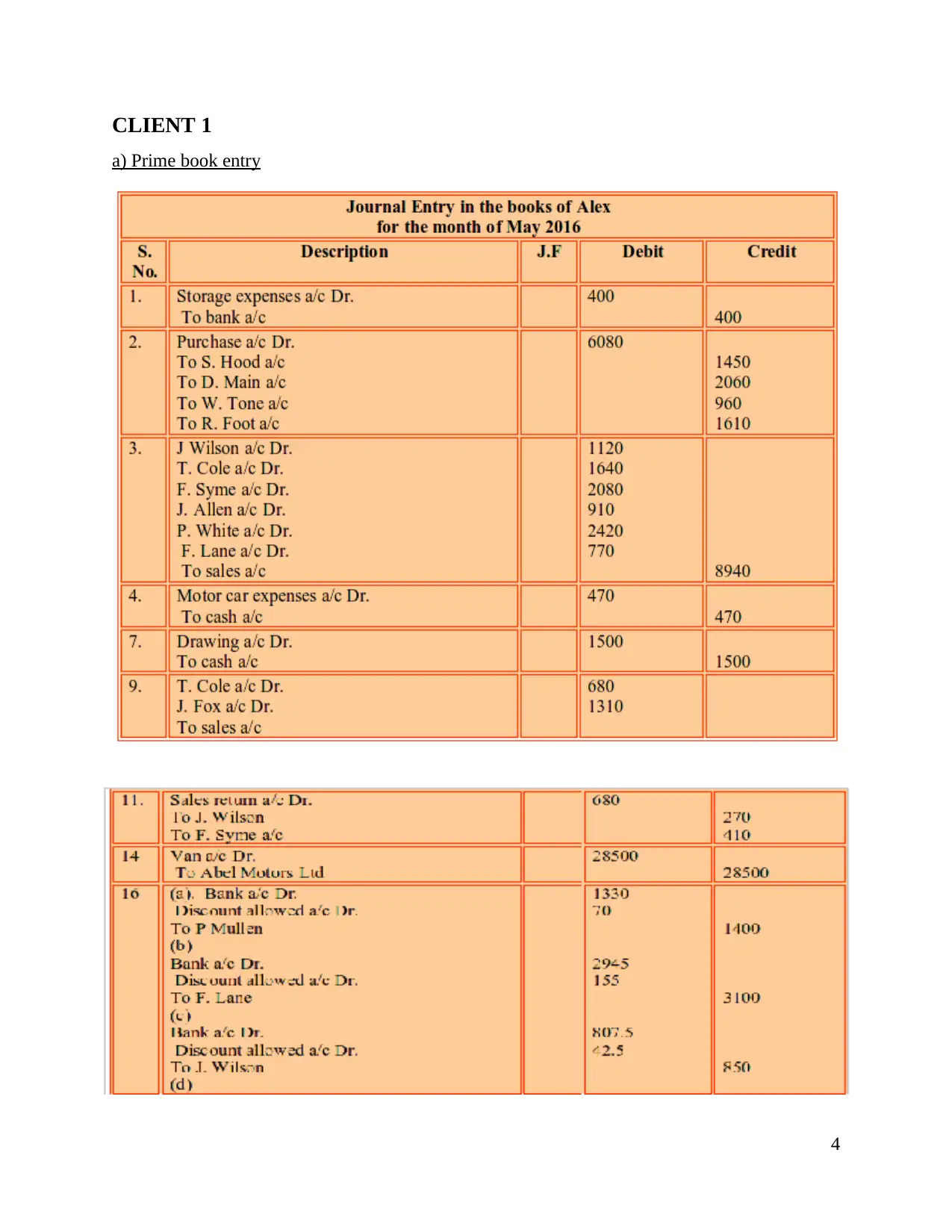
CLIENT 1
a) Prime book entry
4
a) Prime book entry
4
Paraphrase This Document
Need a fresh take? Get an instant paraphrase of this document with our AI Paraphraser

5
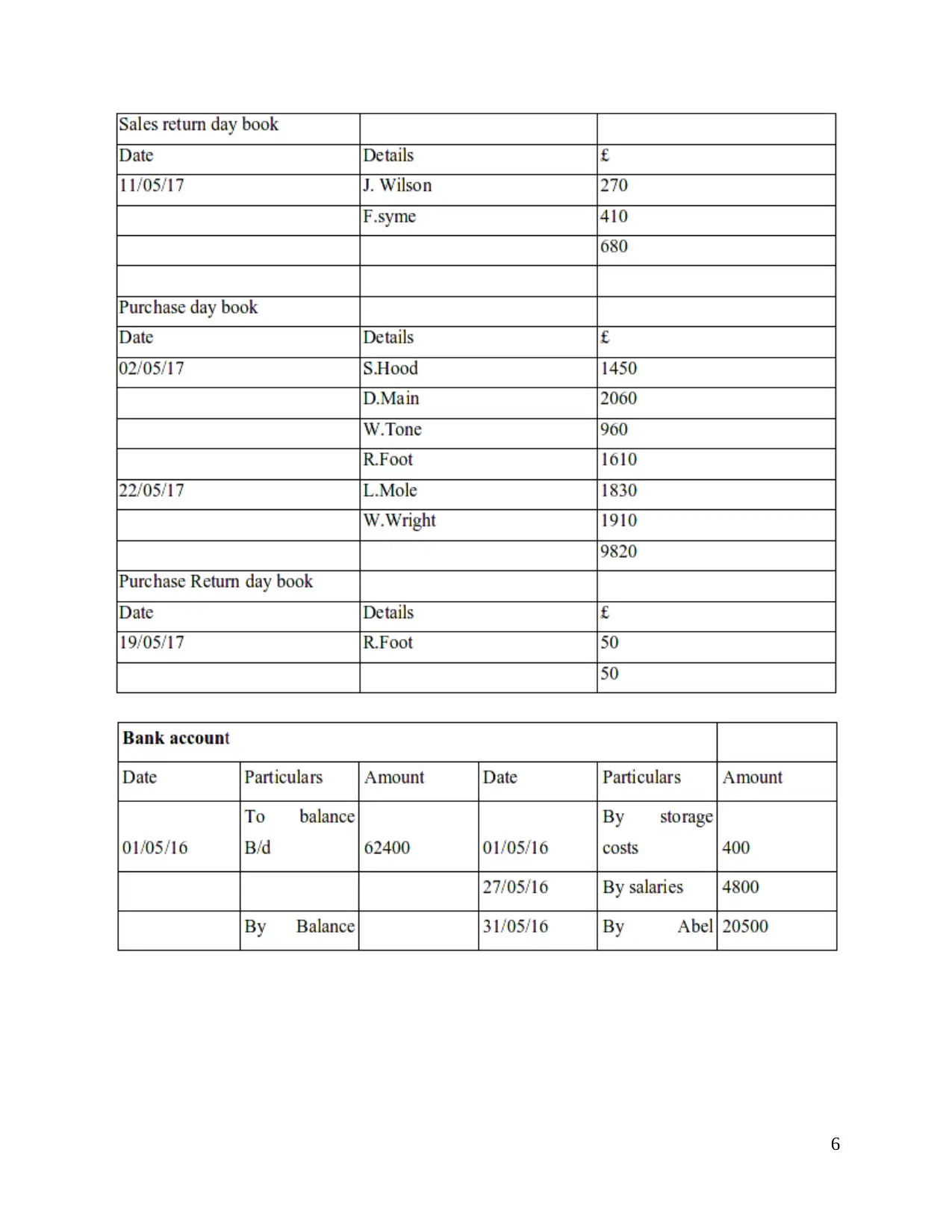
6
⊘ This is a preview!⊘
Do you want full access?
Subscribe today to unlock all pages.

Trusted by 1+ million students worldwide
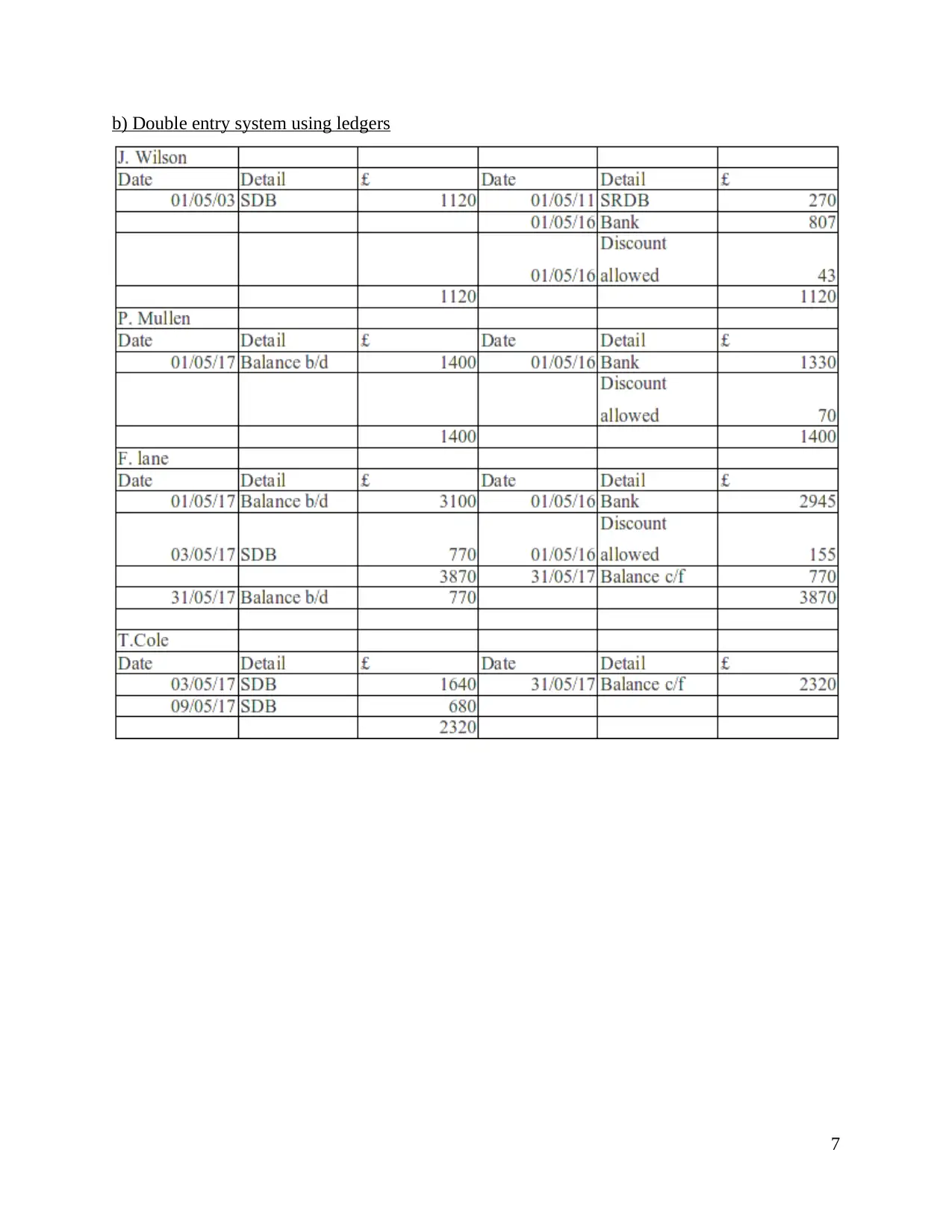
b) Double entry system using ledgers
7
7
Paraphrase This Document
Need a fresh take? Get an instant paraphrase of this document with our AI Paraphraser
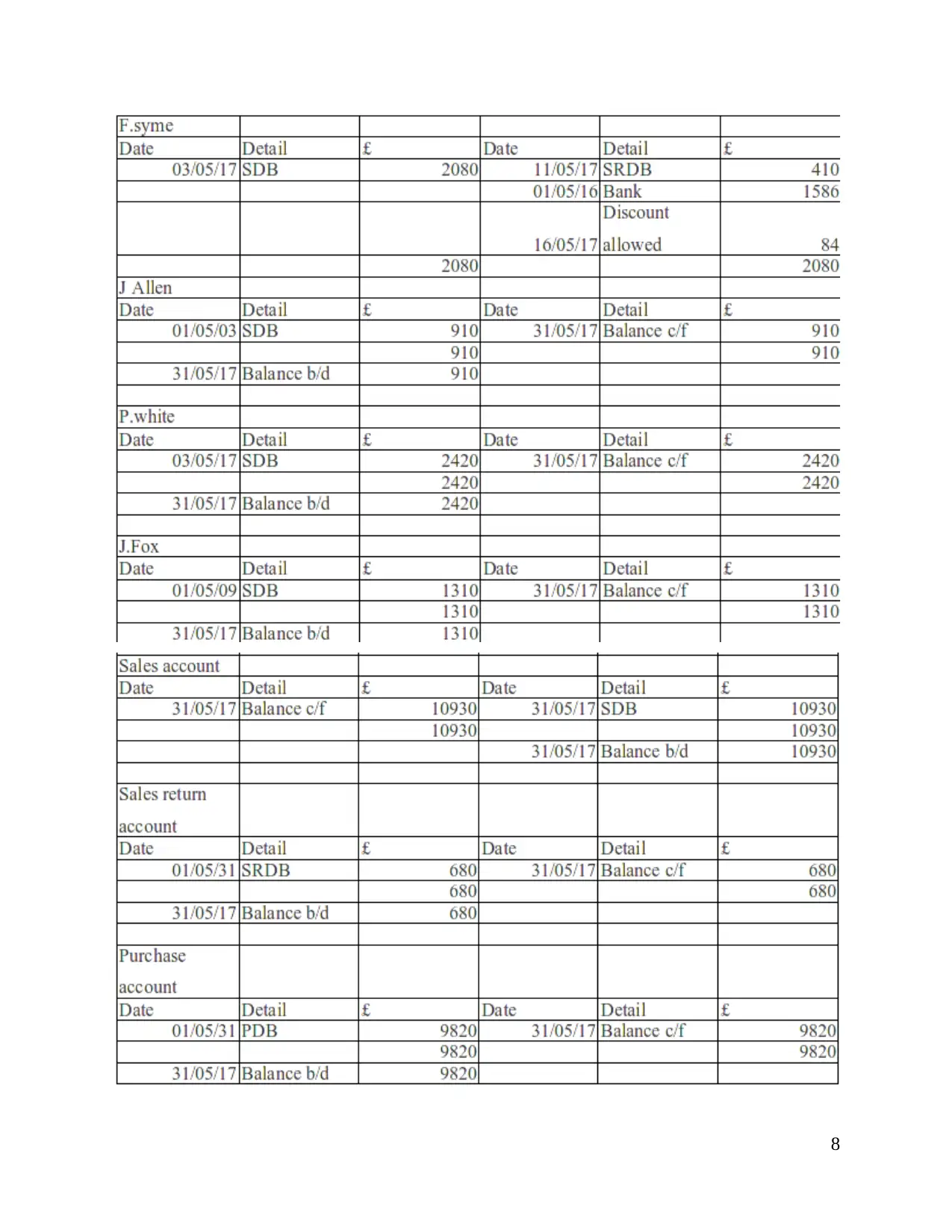
8
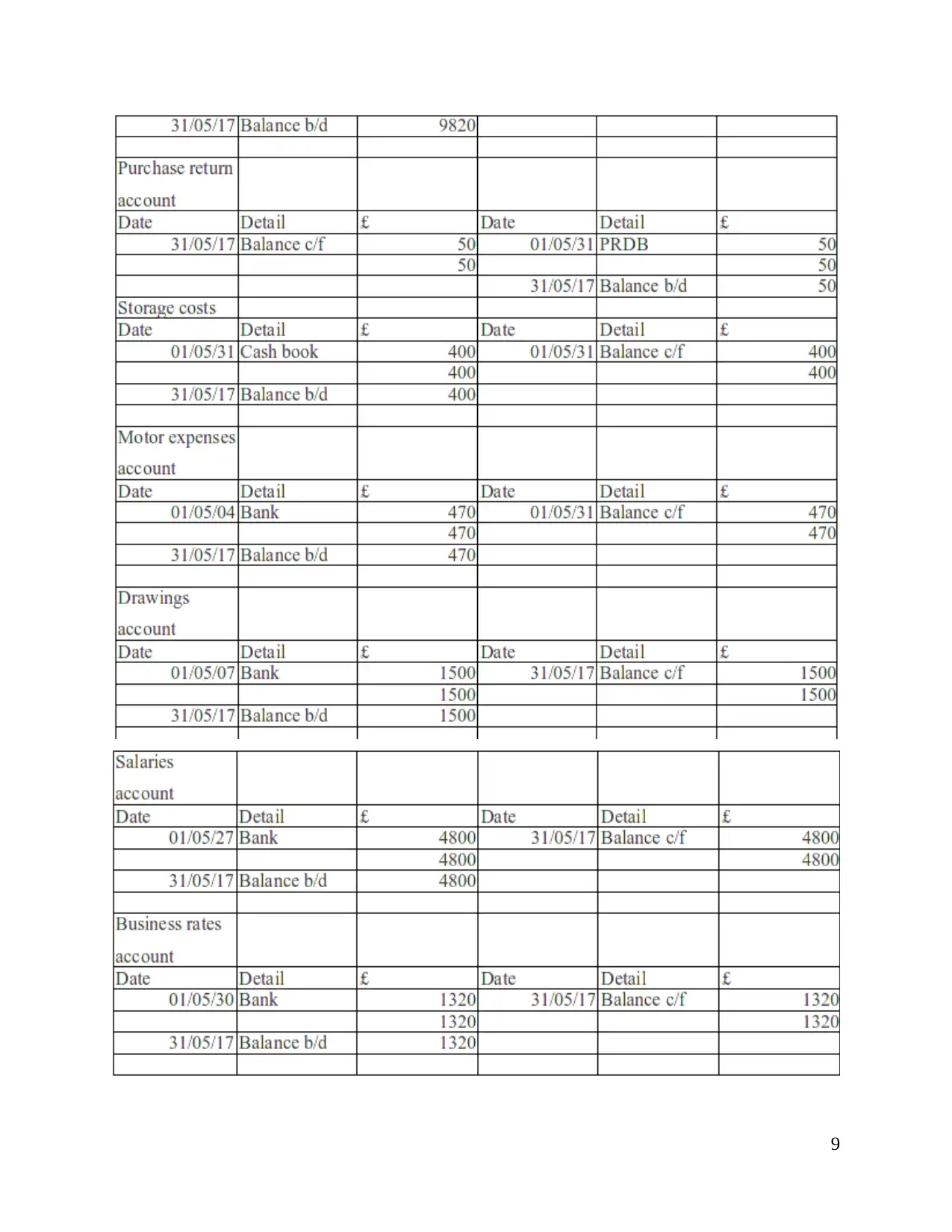
9
⊘ This is a preview!⊘
Do you want full access?
Subscribe today to unlock all pages.

Trusted by 1+ million students worldwide
1 out of 28
Related Documents
Your All-in-One AI-Powered Toolkit for Academic Success.
+13062052269
info@desklib.com
Available 24*7 on WhatsApp / Email
![[object Object]](/_next/static/media/star-bottom.7253800d.svg)
Unlock your academic potential
Copyright © 2020–2025 A2Z Services. All Rights Reserved. Developed and managed by ZUCOL.





